Mariner 9
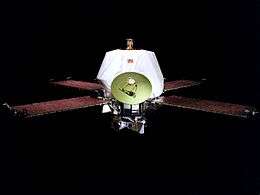 The Mariner 9 spacecraft | |
| Mission type | Mars orbiter |
|---|---|
| Operator | NASA / JPL |
| COSPAR ID | 1971-051A |
| SATCAT № | 5261 |
| Mission duration | 1 year, 4 months, 27 days |
| Spacecraft properties | |
| Manufacturer | Jet Propulsion Laboratory |
| Launch mass | 997.9 kilograms (2,200 lb) |
| Dry mass | 558.8 kilograms (1,232 lb) |
| Power | 500 watts |
| Start of mission | |
| Launch date | May 30, 1971, 22:23:04 UTC |
| Rocket | Atlas SLV-3C Centaur-D |
| Launch site | Cape Canaveral LC-36B |
| End of mission | |
| Disposal | Decommissioned |
| Deactivated | October 27, 1972 |
| Orbital parameters | |
| Reference system | Areocentric |
| Periareion | 1,650 kilometres (1,030 mi) |
| Apoareion | 16,860 kilometres (10,480 mi) |
| Inclination | 64.4° |
| Period | 719.47 minutes |
| Mars orbiter | |
| Orbital insertion | November 14, 1971, 00:42:00 UTC |
Mariner 9 (Mariner Mars '71 / Mariner-I) was an unmanned NASA space probe that contributed greatly to the exploration of Mars and was part of the Mariner program. Mariner 9 was launched toward Mars on May 30, 1971[1][2] from Cape Canaveral Air Force Station and reached the planet on November 14 of the same year,[1][2] becoming the first spacecraft to orbit another planet[3] – only narrowly beating the Soviets' Mars 2 and Mars 3, which both arrived within a month. After months of dust storms it managed to send back clear pictures of the surface.
Mariner 9 returned 7329 images over the course of its mission, which concluded in October 1972.[4]
Objectives

Mariner 9 was designed to continue the atmospheric studies begun by Mariner 6 and 7, and to map over 70% of the Martian surface from the lowest altitude (1,500 kilometers (930 mi)) and at the highest resolutions (from 1 kilometer per pixel to 100 meters per pixel) of any Mars mission up to that point. An infrared radiometer was included to detect heat sources in search of evidence of volcanic activity. It was to study temporal changes in the Martian atmosphere and surface. Mars' two moons were also to be analyzed. Mariner 9 more than met its objectives.
Under original plans, a dual mission was to be flown like Mariners 6-7, however the launch failure of Mariner 8 ruined this scheme and forced NASA planners to fall back on a simpler one-probe mission. NASA still held out hope that another Mariner probe and Atlas-Centaur could be readied before the 1971 Mars launch window closed. A few logistical problems emerged, including the lack of an available Centaur payload shroud of the correct configuration for the Mariner probes, however there was a shroud in NASA's inventory which could be modified. Convair also had an available Centaur stage on hand and could have an Atlas readied in time, but the idea was ultimately abandoned for lack of funding.
Mariner 9 was mated to Atlas-Centaur AC-23 on May 9 with investigation into Mariner 8's failure ongoing. The malfunction was traced to a problem in the Centaur's pitch control servoamplifier and because it was not clear if the spacecraft itself had been responsible, RFI testing was conducted on Mariner 9 to ensure the probe was not releasing interference that could cause problems with the Centaur's electronics. All testing came back negative and on May 22, a tested and verified rate gyro package arrived from Convair and was installed in the Centaur.
Liftoff took place on May 30 at 5:23 PM EST. All launch vehicle systems performed normally and the Mariner separated from the Centaur at 13 minutes and 18 seconds after launch.
Experiments
- Ultraviolet Spectrometer (UVS)
- Infrared Interferometer Spectrometer (IRIS)
- Celestial Mechanics (not a separate instrument; it relied upon tracking measurements including range, range rate, and Doppler)
- S-Band Occultation (not a separate instrument; experiment observed the attenuation of the communication signal as the orbiting satellite passed out of view)
- Infrared Radiometer (IRR)
- Visual Imaging System – in a lower orbit, half that of Mariner 6 and Mariner 7 flyby missions, and with a vastly improved imaging system, Mariner 9 achieved a resolution of 320 feet (98 m) per pixel, whereas previous Martian probes had achieved only approximately 2,600 feet (790 m) per pixel.[5]
Achievements
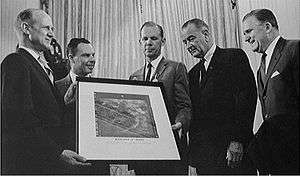
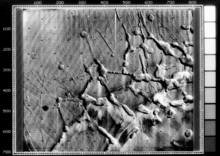
Mariner 9 was the first spacecraft to orbit another planet. It carried an instrument payload similar to Mariners 6 and 7, but because of the need for a larger propulsion system to control the spacecraft in Martian orbit, it weighed more than Mariners 6 and 7 combined.[5]
When Mariner 9 arrived at Mars on November 14, 1971, planetary scientists were surprised to find the atmosphere was thick with "a planet-wide robe of dust, the largest storm ever observed." The surface was totally obscured. Mariner 9's computer was thus reprogrammed from Earth to delay imaging of the surface for a couple of months until the dust settled. The main surface imaging did not get underway until mid-January 1972. However, surface-obscured images did contribute to the collection of Mars science, including understanding of the existence of several huge high-altitude volcanoes of the Tharsis Bulge that gradually became visible as the dust storm abated. This unexpected situation made a strong case for the desirability of studying a planet from orbit rather than merely flying past.[5] It also highlighted the importance of flexible mission software. The Soviet Union's Mars 2 and Mars 3 probes, which arrived during the same dust storm, were unable to adapt to the unexpected conditions, which severely limited the amount of data that they were able to collect.
After 349 days in orbit, Mariner 9 had transmitted 7,329 images, covering 85% of Mars' surface, whereas previous flyby missions had returned less than one thousand images covering only a small portion of the planetary surface.[7] The images revealed river beds, craters, massive extinct volcanoes (such as Olympus Mons, the largest known volcano in the Solar System; Mariner 9 led directly to its reclassification from Nix Olympica), canyons (including the Valles Marineris, a system of canyons over about 2,500 miles (4,020 km) long), evidence of wind and water erosion and deposition, weather fronts, fogs, and more.[8] Mars' small moons, Phobos and Deimos, were also photographed.[9] [10]
The findings from the Mariner 9 mission underpinned the later Viking program.[5]
The enormous Valles Marineris canyon system is named after Mariner 9 in honor of its achievements.[5]
After depleting its supply of attitude control gas, the spacecraft was turned off on October 27, 1972.[5]
Construction
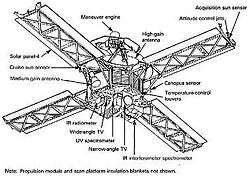
The ultraviolet spectrometer aboard Mariner 9 was constructed by the Laboratory for Atmospheric and Space Physics at the University of Colorado, Boulder, Colorado. The ultraviolet spectrometer team was led by Professor Charles Barth.
The Infrared Interferometer Spectrometer (IRIS) team was led by Dr. Rudolf A. Hanel from NASA Goddard Spaceflight Center (GSFC). The IRIS instrument was built by Texas Instruments, Dallas, Texas.
The Infrared Radiometer (IRR) team was led by Professor Gerald Neugebauer from the California Institute of Technology (Caltech).
Error-Correction Codes achievements
To control for errors in the reception of the grayscale image data sent by Mariner 9 (caused by a low signal-to-noise ratio), the data had to be encoded before transmission using a so-called error-correcting code (ECC). Without ECC, noise would have made up roughly a quarter of a received image, while the ECC encoded the data in a redundant way which allowed for the reconstruction of the sent image data at reception.
As the flown hardware was constrained with regards to weight, power consumption, storage and computing power, some considerations had to be put into choosing an error-correcting code, and it was decided to use a Hadamard code for Mariner 9. Each image pixel was represented as a 6-bit binary value, which had 64 possible grayscale levels. Because of limitations of the transmitter, the maximum useful data length was about 30 bits. Instead of using a repetition code, a [32, 6, 16] punctured Hadamard code was used, which is also a 1st-order Reed-Muller code. Errors of up to seven bits per each 32-bit word could be corrected using this scheme. Compared to a five-repetition code, the error correcting properties of this Hadamard code were much better, yet its rate was comparable. The efficient decoding algorithm was an important factor in the decision to use this code. The circuitry used was called the "Green Machine", which employed the fast Fourier transform, increasing the decoding speed by a factor of three.[11]
Present location
Mariner 9 remains a derelict satellite in Mars orbit.[5] It is expected to remain in orbit until approximately 2022, when the spacecraft is projected to enter the Martian atmosphere and either burn up or crash into the planet's surface.[12]
See also
- Exploration of Mars
- List of Mars orbiters
- List of missions to Mars
- Space exploration
- Timeline of artificial satellites and space probes
- Unmanned space missions
- Mars flyby
References
- 1 2 "Mariner 9: Trajectory Information". National Space Science Data Center. Retrieved December 28, 2011.
- 1 2 "Mariner Mars 1971 Project Final Report" (PDF). NASA Technical Reports Server. Retrieved December 28, 2011.
- ↑ "Mariner 9: Details". National Space Science Data Center. Retrieved December 28, 2011.
- ↑ NASA PROGRAM & MISSIONS Historical Log
- 1 2 3 4 5 6 7 Pyle, Rod (2012). Destination Mars. Prometheus Books. pp. 73–78. ISBN 978-1-61614-589-7.
It was the first spacecraft to enter orbit around another world. ... [It] continues to orbit Mars to this day, sailing around the planet deaf and dumb in the cold darkness.
- ↑
- ↑ http://solarsystem.nasa.gov/missions/profile.cfm?Sort=Target&Target=Mars&MCode=Mariner_09&Display=ReadMore
- ↑ http://www.space.com/18439-mariner-9.html
- ↑ Mars Exploration Program: Mariner 8 & 9
- ↑ Hartmann, W. O. Raper. 1974. The New Mars. The Discoveries of Mariner 9. With the Cooperation of the Mariner 9 Science Experiment Team. Prepared for the NASA Office of Space Science.
- ↑ Combinatorics in Space The Mariner 9 Telemetry System
- ↑ NASA - This Month in NASA History: Mariner 9, November 29, 2011 – Vol. 4, Issue 9 Archived May 14, 2013, at the Wayback Machine.
External links
| Wikimedia Commons has media related to Mariner 9. |
- Mariner 9 Mission Profile by NASA's Solar System Exploration
- NSSDC Master Catalog: Spacecraft – Mariner 9
- NASA-JPL Guide to Mariner 9
- some Mariner 9 images of Mars
- Mariner 9 approaching Mars movie
- Mariner 9 images, including dust storm
- Mariner 9 view of Phobos (hosted by The Planetary Society)
- Mariner 9 image compared to MGS image, helps determine if Dunes moved in decades
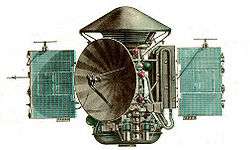

.jpg)
.jpg)